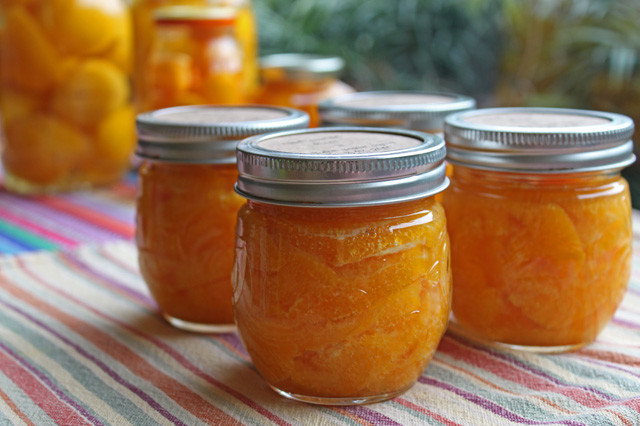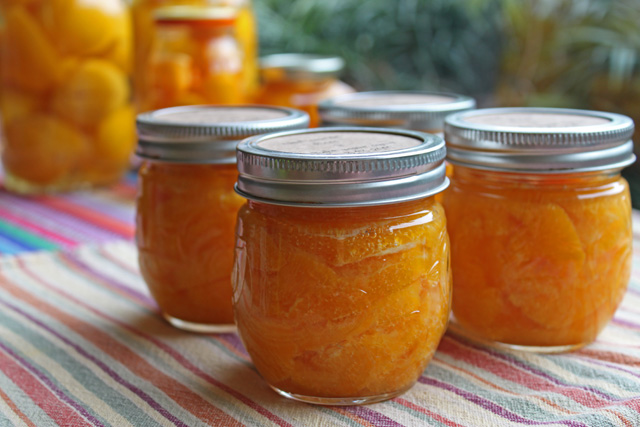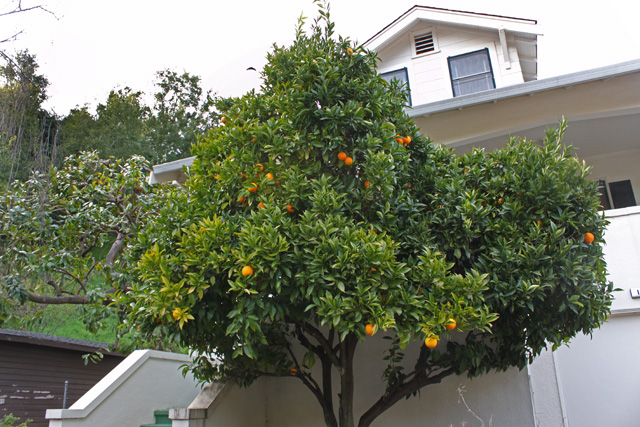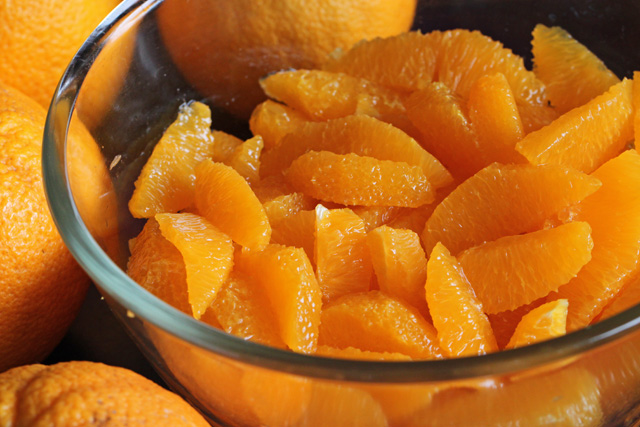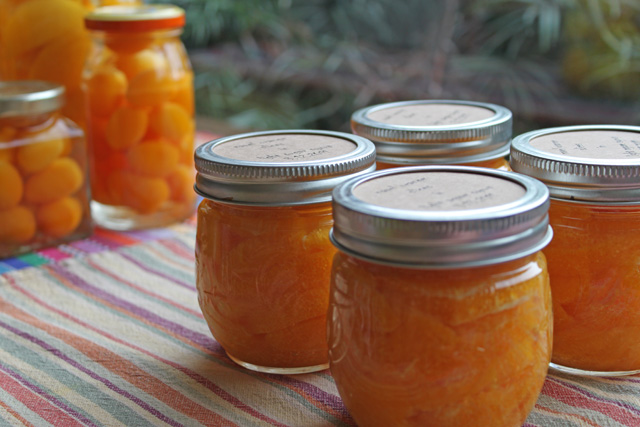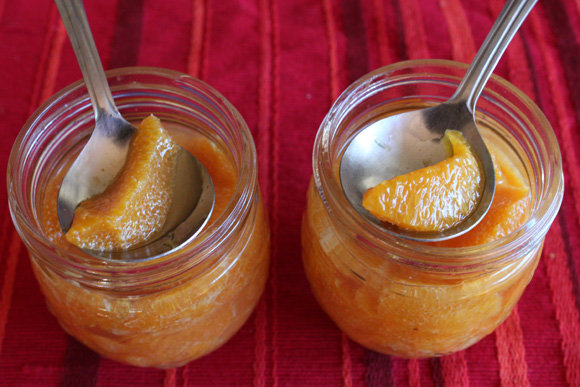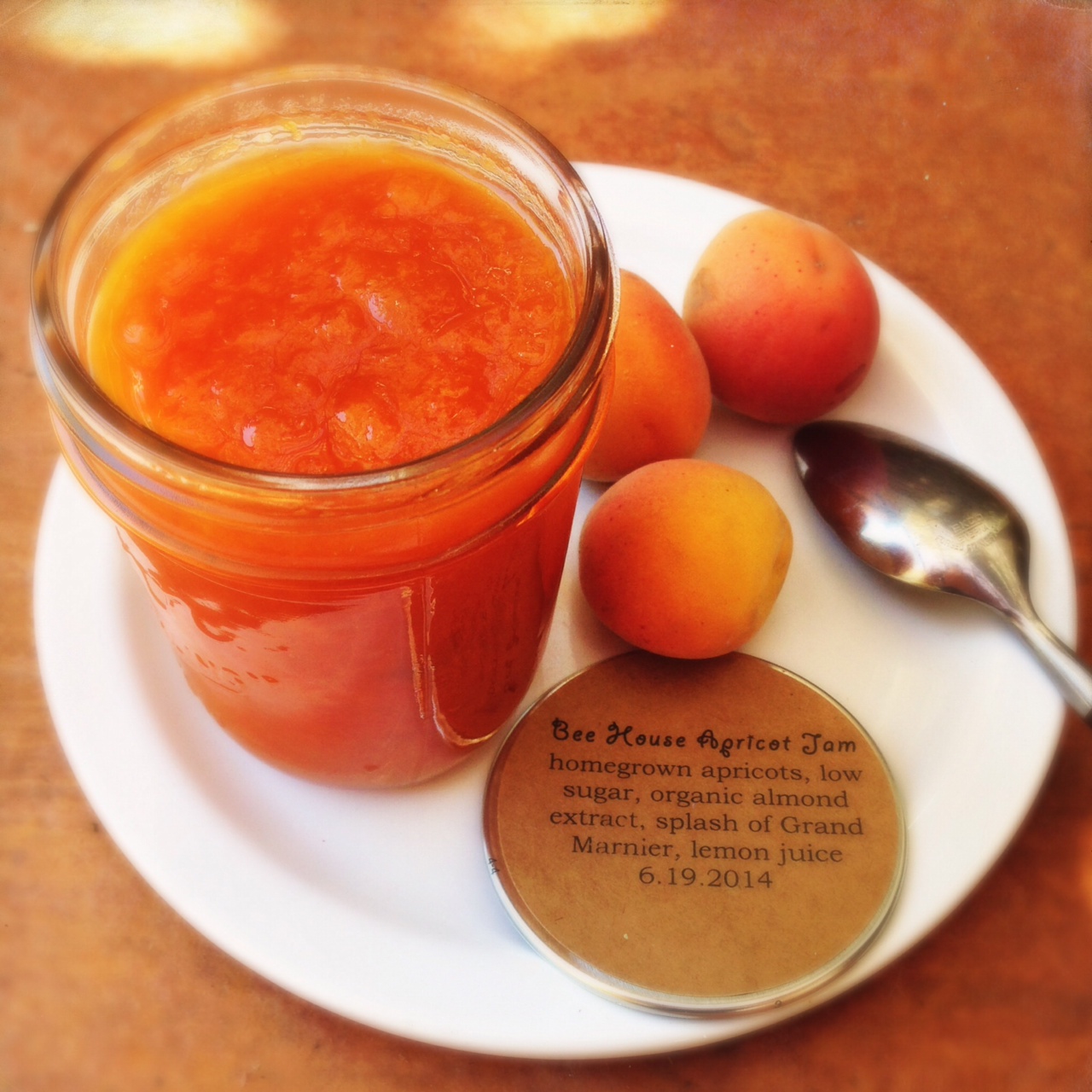This post could also be called “Experiments with Oranges,” because that’s what’s happening here. The jars above contain orange segments preserved two ways: half in light sugar syrup and half in a light syrup made with organic agave nectar. Trying agave is part of my new interest in preserving fruit without refined sugar. My plan is to open a jar of each type in three months and then again in six months, to see how they compare.
Agave nectar, derived from plants grown in Mexico, is a sweetener in syrup form. Agave is composed mostly of fructose, but contains glucose as well. (Apparently, the exact proportions can vary rather wildly from brand to brand.) In truth, agave is not all that different from sugar, though it comes with a lower glycemic index and one clear advantage: It’s much sweeter than sugar, so you can use less of it. In this way, it’s much like honey. In fact, I would have used good local honey instead of agave for this experiment, but I didn’t really want the honey flavor in these jars.
Now, enter the oranges. My friend has a Navel orange tree of serious proportions . . .
I’m not kidding, right? These oranges are lovely. They are sweet and at their very best eaten out of hand. (“Twist them off,” Joanne says, “Don’t pull or snip. It’s better for the tree.” Then toss the rinds underneath where they can feed the roots.) Last week, I brought home a basket of about thirty oranges — enough for both eating and preserving, though I had to work quickly. After just a few days, these tender beauties start to go soft.
A quick look tells you why they are called Navels. Some have innies and some have outies . . .
To cut clean segments from these oranges, I used my best, sharpest knife and this video on How to Supreme an Orange from Updown Group Food & Drink. (Take note when he says to cut along each side of the membrane, because he doesn’t actually show the second cut.)
I laughed at myself because I didn’t know how to pronounce “supreme.” I thought it was like Diana Ross. But it’s suprême — that is, Su-PREHM. It’s French. The term can be a verb or a noun. You supreme the fruit, but the wedge itself is also a supreme.
The process described below can be adapted for whatever volume of orange segments you have. As a rough guide, I needed only about 1/3 cup of prepared syrup for each half-pint jar of raw-packed fruit. I’ll start by listing the ingredients for the syrups — choose whichever one you want — and then I’ll explain the method I used.
Light Sugar Syrup
3/4 cup white sugar
1 3/4 cups water
Light Agave Syrup
2 1/2 tablespoons organic agave nectar
2 teaspoons lemon juice
1 cup water
1. Supreme the oranges and choose enough half-pint or pint jars to hold them. Keep in mind that the fruit will pack way down and the jars should be packed nice and tight. My four half-pint jars contain the segments of almost twenty oranges! But these oranges were super thick skinned and contained relatively little fruit. Yours may be very different.
2. Sterilize the jars. Because the fruit is packed into the jars raw — called, surprise, a “raw pack” as opposed to a “hot pack” (explained below) — it’s very important that the jars and lids are hot and sterile.
3. Heat the syrup, bringing it to a gentle simmer without scorching, and keep it hot.
4. Pack the fruit into the hot jars, leaving 3/4″ at the top, then cover with hot syrup of your choice, leaving 1/2″ head space. Be sure to “bubble” your jars — that is, run a small silicone spatula or a chopstick around the insides to release all the air bubbles and help the syrup settle into place. The head space is critical here. The fruit will expand somewhat during processing and, without enough space, the liquid will be forced out of the jars, compromising the seal.
5. Process sugar-syrup jars in a hot water bath for 10 minutes. Process agave-syrup jars for 15 minutes.
Safety Notes: I determined these methods and processing times using two sources: the 
 . I want to be very clear that the two resources differ in their methods for preserving with non-sugar syrups. The Blue Book advocates a hot pack for sugar-free preserving — essentially, you cook the fruit in the syrup until it is hot all the way through, then you pack the hot fruit into sterilized jars. MacRae goes with a raw pack for sugar-free citrus segments, but she uses a longer processing time. I chose the latter method. It requires less syrup and allows the fruit to retain more integrity. I expect that the 15 minutes she suggests was plenty of time for adequate heat to penetrate to the center of these small jars, and I’m willing to take the risk because this is highly acidic fruit where botulism growth isn’t a possibility. It’s only the moldy stuff we have to watch out for here. If I open my jars and smell or see anything odd, I’ll chuck the contents. If you have any doubts about proceeding with the raw-pack method, by all means go with a hot pack.
. I want to be very clear that the two resources differ in their methods for preserving with non-sugar syrups. The Blue Book advocates a hot pack for sugar-free preserving — essentially, you cook the fruit in the syrup until it is hot all the way through, then you pack the hot fruit into sterilized jars. MacRae goes with a raw pack for sugar-free citrus segments, but she uses a longer processing time. I chose the latter method. It requires less syrup and allows the fruit to retain more integrity. I expect that the 15 minutes she suggests was plenty of time for adequate heat to penetrate to the center of these small jars, and I’m willing to take the risk because this is highly acidic fruit where botulism growth isn’t a possibility. It’s only the moldy stuff we have to watch out for here. If I open my jars and smell or see anything odd, I’ll chuck the contents. If you have any doubts about proceeding with the raw-pack method, by all means go with a hot pack.
I’ll report back here when I open these jars on June 15 and September 15. Meanwhile, if you’ve ever experimented with oranges, will you tell me about it? Have you preserved them in agave? Honey? Fruit juice? Nothing but their own juice and boiling water? (That can be done.) I’d love to know.
Finally, for those who like the other kind of Supreme as much as I do, I am including this video, too. What in the world were these white kids on? They are dancing like zombies.
October 2011 Update!
I promised an update on these orange slices at three months, and then again at six months. Turns out to be seven months instead of six, but here I am with information to share . . .
At three months — on June 15, 2011 — I noticed no difference between the two jars I opened. You can find the report and a photo here.
At seven months, the contents of the two jars have gone noticeably separate ways. The flavor of the oranges in both jars is equal and good. But that’s where the similarities end. The color of the oranges preserved in agave syrup is somewhat sullen, compared to its neighbor. (Can you tell from the photo below? The agave-preserved oranges are on the left, sugar-preserved on the right.) What’s most obvious to me, however, is the poor texture of the agave-jarred fruit. The oranges are mushy. The fruit preserved in sugar — and remember, it wasn’t all that much sugar — still pops a bit when you bite into it; the cell structure is still intact.
Without a doubt, I prefer the orange segments preserved in light sugar syrup, but which to choose depends entirely on what you value. Remember, neither batch actually spoiled — and they both taste good!

